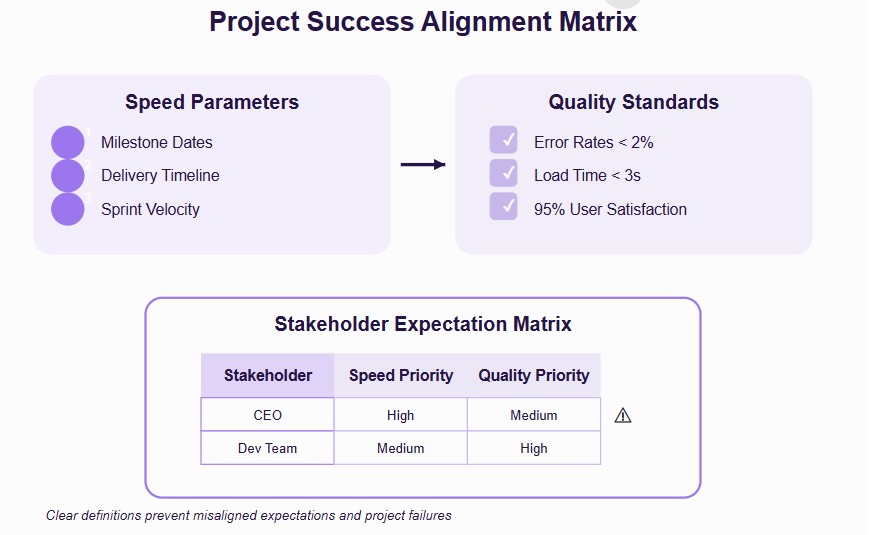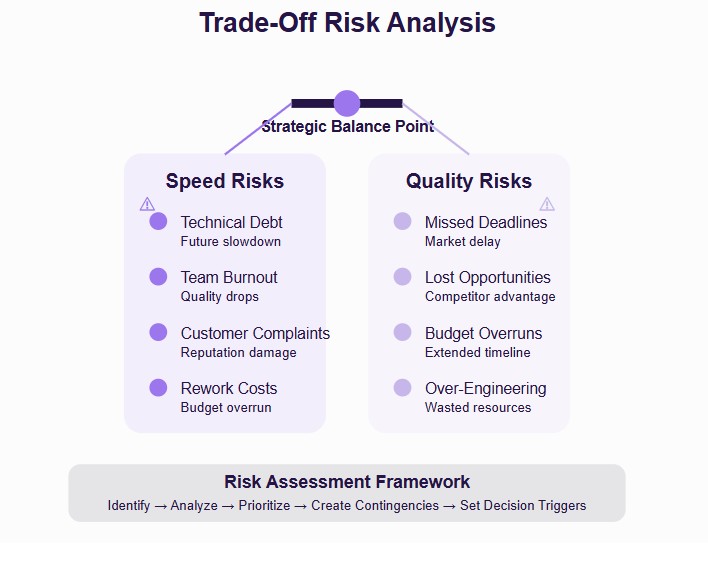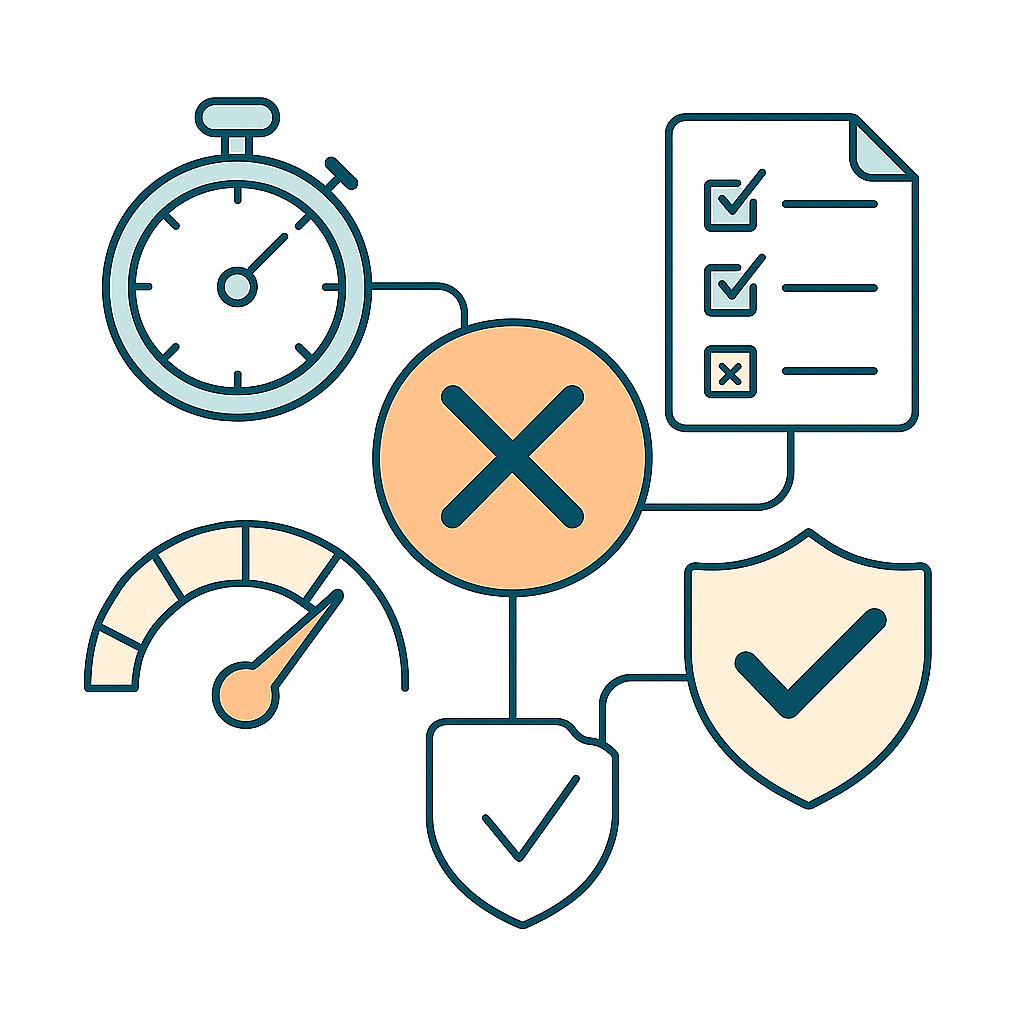Projects delivered too quickly are twice as likely to fail, yet over-polishing can stall growth and frustrate teams. Learning how to balance speed vs. quality in projects is essential to hitting deadlines without sacrificing standards.
From missed opportunities to technical debt, the cost of imbalance is real, but with the right approach, both speed and quality can work in sync.
In this article, we will explore:
- Follow these steps to deliver faster without sacrificing quality
- Learn how top industries manage speed and quality differently
- Avoid costly project failures by fixing these speed-quality traps
Master the balance: A step-by-step framework to deliver projects fast without compromising quality
Every project manager faces the same dilemma: deliver fast and risk quality issues, or focus on perfection and miss critical deadlines. The truth is, speed and quality aren't enemies – they can work together when you follow the right framework.
Step 1: Define what "speed" and "quality" mean for this project
Most project failures stem from unclear definitions of success. Without specific parameters, your team will make assumptions that lead to misaligned expectations and wasted effort.
- Speed metrics: Define specific deadlines, milestone dates, and delivery timelines
- Quality standards: Establish measurable criteria like performance benchmarks, error rates, or customer satisfaction scores
- Stakeholder alignment: Document what each stakeholder considers "fast enough" and "good enough"
- Success criteria: Create clear pass/fail thresholds for both speed and quality objectives

Pro Tip: Use a simple matrix to map stakeholder expectations. List each stakeholder on one axis and their speed/quality priorities on the other. This reveals conflicts early and helps you negotiate realistic expectations.
Step 2: Identify project constraints using the iron triangle
The iron triangle of scope, time, and cost determines every project's reality. Smart project managers use this framework to make conscious trade-offs instead of hoping everything will work out.
- Fixed constraints: Identify which elements cannot change (regulatory deadlines, budget limits, core features)
- Flexible elements: Determine what can be adjusted if needed (nice-to-have features, delivery sequence)
- Priority ranking: Force-rank the three constraints to guide decision-making under pressure
- Stakeholder buy-in: Get written agreement on constraint priorities from all key stakeholders

Real-World Example: A software company building a regulatory compliance feature discovered their deadline was fixed (legal requirement), and the budget was limited. This clarity helped them focus on core compliance requirements first, adding enhancements later.
Step 3: Run a risk assessment on each trade-off
Every speed-versus-quality decision carries hidden risks that can derail your project later. Conducting upfront risk analysis helps you make informed trade-offs and prepare contingency plans.
- Speed risks: Customer complaints, technical debt, rework costs, team burnout, reputation damage
- Quality risks: Missed deadlines, market opportunities lost, competitor advantage, and budget overruns
- Mitigation strategies: Develop specific action plans for your highest-probability risks
- Decision triggers: Set clear criteria for when to pivot between speed and quality focus

Risk Assessment Template: Create a 2x2 matrix with "Probability" and "Impact" axes. Focus mitigation efforts on the high-probability, high-impact quadrant first.
Step 4: Break the project into phases or increments
Phased delivery is the secret weapon for balancing speed and quality. Instead of trying to optimize both simultaneously, you can emphasize speed in some phases and quality in others.
- MVP phase: Focus on speed to get early market validation and stakeholder feedback
- Enhancement phases: Gradually increase quality standards as requirements become clearer
- Critical phases: Identify where quality cannot be compromised (security, compliance, customer-facing features)
- Buffer phases: Build in time for quality improvements between major releases
Success Story: Netflix launched with a basic DVD-by-mail service (speed focus) before investing heavily in streaming quality. This phased approach captured market share quickly while building toward their long-term vision.
Step 5: Use agile or hybrid methodologies to iterate safely
Agile methodologies, when paired with AI project management software for it professionals, offer a powerful framework for balancing speed and quality through controlled iteration. Short cycles allow you to deliver value quickly while maintaining quality through continuous feedback.
- Sprint planning: Include both speed targets and quality checkpoints in each iteration
- Daily standups: Address speed-quality tensions as they arise, not at the end
- Retrospectives: Regularly assess and adjust your speed-quality balance based on results
- Hybrid approaches: Combine agile sprints with waterfall quality gates for regulated industries
Methodology Guide: Use Scrum for software development requiring flexibility, Kanban for continuous delivery environments, and hybrid approaches for projects with fixed regulatory requirements.
Step 6: Set quality thresholds, not perfection
"Good enough" is a strategic decision, not a compromise. Setting clear quality thresholds prevents endless perfectionism while ensuring you meet stakeholder needs.
- Minimum viable quality: Establish the lowest acceptable standard for each deliverable type
- Performance benchmarks: Set specific, measurable quality criteria (load times, error rates, satisfaction scores)
- Acceptance criteria: Create clear pass/fail tests for every major deliverable
- Quality gates: Define review points where work must meet thresholds before proceeding
80/20 Quality Rule: Focus 80% of quality efforts on the 20% of features that matter most to users. For a mobile app, this means perfect core functionality while accepting minor issues in advanced settings.
Step 7: Align the entire team around these rules
Team alignment determines whether your speed-quality framework works in practice. Everyone needs to understand not just what the rules are, but how to apply them under pressure.
- Kickoff documentation: Include speed-quality priorities in all project planning documents
- Decision authority: Clarify who makes speed-versus-quality calls when conflicts arise
- Communication protocols: Establish how and when to escalate speed-quality tensions
- Regular check-ins: Review and adjust the balance based on project progress and feedback

Team Exercise: Have each member write down their understanding of the project's speed and quality priorities. Compare responses to ensure everyone works toward the same definition of success.
This framework works because it forces conscious decision-making instead of hoping speed and quality will balance themselves. The most successful teams revisit these steps regularly, adjusting their approach based on changing requirements.
Industry playbooks: How different sectors balance speed and quality in projects
Different industries have mastered unique approaches to the speed-quality balance based on their regulatory requirements, customer expectations, and market dynamics.
Understanding these sector-specific strategies can help you adapt proven frameworks to your projects, regardless of your industry.
Tech & startups: Speed wins - until it breaks things
In tech and startup culture, speed is survival. The focus is on launching quickly, gaining user feedback, and iterating rapidly. Quality isn’t ignored, but it’s often deliberately limited to core functionality.
- MVP-first mindset: Ship a usable product fast, even if rough around the edges
- Fail-fast approach: Use early failures as learning tools, not setbacks
- User feedback loops: Prioritize improvement based on real usage, not perfectionism
- Time-boxed releases: Speed is built into the culture through tight sprints and deadlines
Example: Instagram’s first version only had photo uploads and filters - everything else came after market validation.
Healthcare & pharma: Quality isn’t optional
In regulated environments like healthcare, quality takes precedence - because errors can cost lives or trigger legal consequences. Projects must meet compliance standards, validation protocols, and documentation requirements before anything can be released.
- Strict regulatory approval cycles (FDA, EMA, etc.)
- Risk mitigation protocols before deployment
- Formal testing phases: Quality assurance must be documented and reproducible
- Zero-defect tolerance for critical functions (e.g., patient data, dosage systems)
Pro Tip: In this environment, it’s better to build delivery speed around quality checkpoints—not the other way around.
Construction & manufacturing: Tolerances, not perfection
Construction and manufacturing deal with physical materials, so the speed-quality trade-off is handled through engineering tolerances - predefined thresholds that determine what’s acceptable.
- Lean project management to reduce waste without compromising safety
- Tolerance limits: A wall may be off by 1mm - but not 10
- Predefined specs dictate both speed and quality parameters
- Stage-gated approvals before moving to next phases (design → execution → QA)
Example: In modular home building, speed improves with prefab components—but each piece must pass structural inspection before it’s assembled.
Enterprise software: Balance through phased releases
Large-scale software systems aim to achieve both reliability and release velocity by dividing delivery into stages. The goal is to provide value incrementally while maintaining stability, security, and user trust.
- Beta testing cycles to validate core features before full-scale deployment
- Canary releases: Roll out to a small user group to monitor quality before wider launch
- Automated testing pipelines to keep speed and QA in sync
- Stakeholder alignment ensures no phase is rushed at the cost of critical business logic
Pro Tip: Use quality metrics (e.g., error rates, rollback frequency) to decide how quickly you can move from one phase to the next.
Quick comparison table: Speed vs. quality by industry
The most successful project managers borrow strategies across industries rather than staying locked into their sector's traditional approach. A startup might benefit from healthcare's risk assessment methods, while a pharmaceutical company could accelerate development using tech's iteration principles.
Fatal speed vs quality mistakes that kill projects (and how to avoid them)
Even experienced project managers fall into predictable traps when balancing speed and quality. These costly mistakes can derail projects, damage team morale, and hurt your professional reputation.
Here's how to recognize and solve the most common speed-quality pitfalls.

Rushing Into execution without strategic planning
The Problem: Teams skip proper planning to start "moving fast," believing that action equals progress. This leads to unclear requirements, missed dependencies, and expensive rework that ultimately makes projects slower and more expensive than if they'd been planned properly from the start.
The Solution: Invest 15-20% of your project timeline in upfront planning. Create a simple planning checklist: define success criteria, identify key risks, map dependencies, and align stakeholders on priorities. One week of planning prevents months of rework.
The perfectionism trap: Over-engineering simple solutions
The Problem: Teams mistake complexity for quality, building unnecessarily sophisticated solutions for straightforward problems. This perfectionism wastes resources, delays delivery, and often creates systems that are harder to maintain and use than simpler alternatives.
The Solution: Define "good enough" criteria before starting work. Ask: "What's the minimum viable quality that meets stakeholder needs?" Use the 80/20 rule - focus 80% of quality effort on the 20% of features that matter most to users.
Poor communication about trade-off decisions
The Problem: Project managers make speed-quality decisions in isolation without stakeholder alignment. Different people expect different outcomes, leading to surprise reactions, blame, and the dreaded "this isn't what we wanted" feedback during delivery.
The Solution: Document every trade-off decision and get a written stakeholder agreement. When choosing speed over quality features, explain why and what the implications are. Create a simple trade-off log that tracks decisions and their rationale.
Failing to set quality thresholds early
The Problem: Without clear quality standards defined upfront, teams either gold-plate everything or deliver substandard work. Quality becomes a moving target that's impossible to hit consistently, leading to scope creep and endless revisions.
The Solution: Create specific, measurable quality criteria during planning. Define pass/fail thresholds for each major deliverable before work begins. Use templates like "This feature passes if it loads in under 2 seconds and handles 100 concurrent users."
Ignoring technical debt and its compound interest
The Problem: Teams accept shortcuts and workarounds to meet speed targets without planning how to address them later. This technical debt accumulates "interest" over time, eventually slowing down all future work and creating maintenance nightmares.
The Solution: Treat technical debt like financial debt. Schedule regular "payments" by allocating 15-20% of each sprint to fixing shortcuts from previous work. Create a debt register that tracks shortcuts and their impact on future development speed.
Fixing these mistakes isn’t about choosing one side; it’s about building a project environment where both speed and quality can co-exist. When you solve the right problems early, everything else gets easier.
Build a culture where speed supports quality, not replaces it
Speed and quality don’t have to compete; they can complement each other when guided by clear priorities, strategic planning, and team-wide alignment. By setting quality thresholds, using agile methods, and learning from cross-industry playbooks, you build a culture where fast delivery doesn’t mean cutting corners.
Protecting your reputation, timeline, and team starts with treating balance as a system, not a guessing game. Build that system, and both speed and quality will thrive.



_light%201.png)





